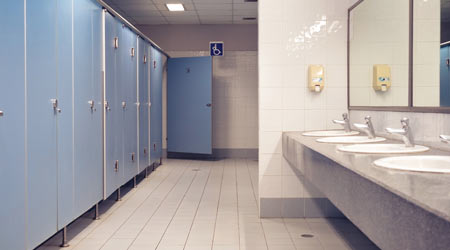 Managers planning plumbing upgrades need to focus on the
key products — toilets, urinals and faucets — whose performance and reliability will determine the project’s long-term success.
Managers planning plumbing upgrades need to focus on the
key products — toilets, urinals and faucets — whose performance and reliability will determine the project’s long-term success.Successful Plumbing Upgrades: Urinals
Toilets, urinals and faucets are key components of plumbing and restroom upgrades that deliver water conservation and savings
Urinals also are important components of water-conservation upgrades to plumbing systems and restrooms. Green building standards have set 0.5 gpf as the water-use limit for urinals across the board, compared to 1 gpf for urinals that have been installed in most existing facilities.
Types of urinals include wash-out, siphon, blowout and waterless. Wash-out urinals typically use 0.125-0.5 gpf and release a stream of water from the top of the urinal to wash away waste via dilution before leaving the trap. Siphon and blow-out urinals offer larger flow rates of 0.5-1 gpf, using the larger water stream to fill the lower bowl and p-trap to create a siphon action via the p-trap. Blowout urinals are typically the more aggressive application and are commonly found in high-use commercial applications, such as stadiums.
As with toilets, managers need to select the appropriate flushometer for the proper corresponding fixture type in both new construction and plumbing system upgrades.
Unfortunately, the drawbacks with any flushometer remain the same with the potential for non-calibrated and faulty devices, which can result in decreased efficiency and loss of water savings. Many urinal manufacturers offer a sleeker, all-in-one model with the flushometer integrated into the porcelain housing, but this can lead to an increased replacement costs — compared to replacing individual components — as well as increased difficulty in troubleshooting potential issues.
Although waterless urinals have come a long way since their inception and are allowed by the corresponding green building ratings, they can present users and maintenance personnel a number of issues. Waterless urinals have their applications and place in facilities, but they might not be the most appropriate option for every situation or application. Newer waterless urinals have increased the trap membrane in order to suppress odors encountered with the original waterless urinals, but these systems still require increased preventive maintenance and material costs related to maintaining and replacing the membranes.
Even managers who have specified newer waterless urinals can probably attest that they do not completely remove the odor and might not be the most appealing option, especially if they add any significant preventive maintenance to already stretched resources.
Faucets
Options for lavatory faucets include manual handle faucets and automatic mixing faucets. Unless a faucet has a specialized use — such as in laboratory or for nutritional applications — managers should be able to specify a 0.5 gallons per minute (gpm) faucet with an aerator or retrofit the existing facility with compliant 0.5 gpm aerators.
Green building standards identify 1.2 or 1.5 gpm for commercial faucets in private lavatory faucets — those not available to the general public — and 0.5 gpm in public settings and 0.25 gallons per cycle for metering faucets regardless of flow rate. Managers can streamline the selection process by looking for the WaterSense label in order to identify fixtures that meet stricter performance standards. Some manufacturers have ventured to go as low as 0.4 gpm for their aerators.
The U.S. Centers for Disease Control and Prevention does warn that the installation of laminar flow restrictors or aerators can promote the growth of Legionella. As a result, they recommend routine cleaning of these devices, as well as necessary testing for Legionella bacteria.
Dan Forino, P.E., CCP, is regional director with Horizon Engineering Associates in New York City. Forino has 11 years of experience in building commissioning and oversees the firm’s health care team, focusing on the regional health care institutions and overseeing their sustainability and indoor air quality consulting divisions.
Related Topics:














